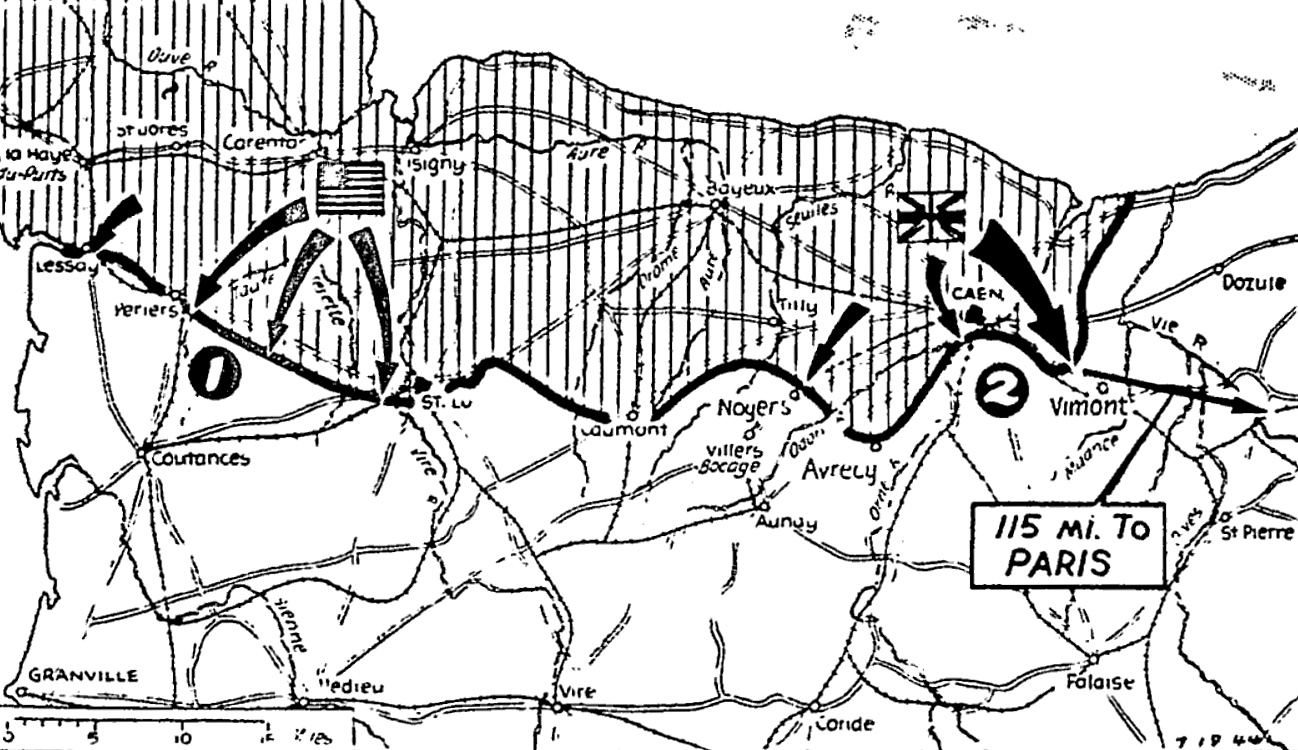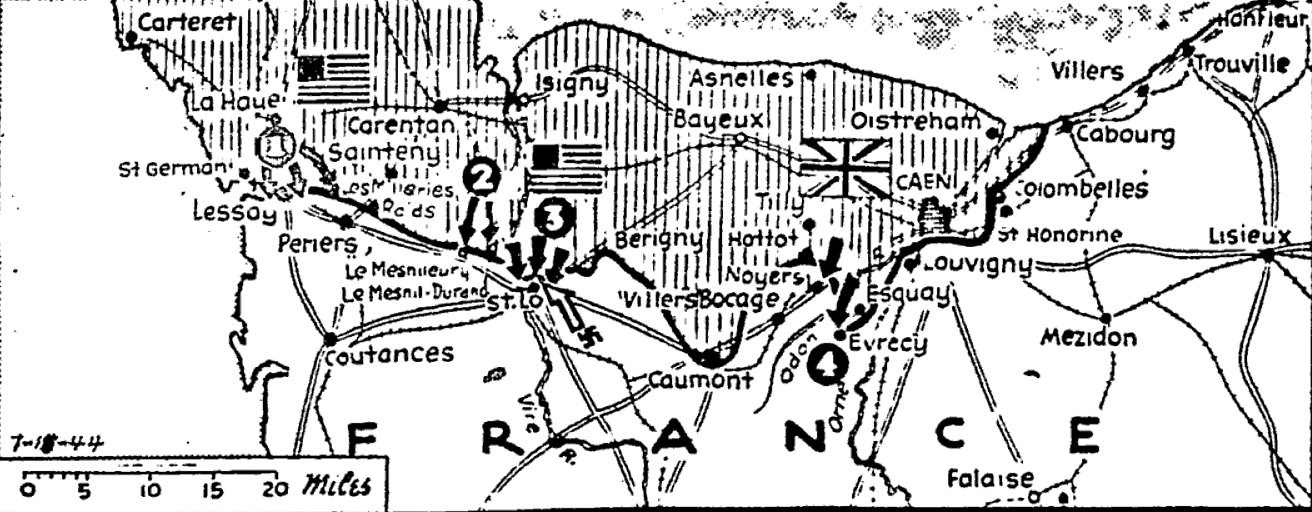The Pittsburgh Press (July 19, 1944)
Great armored battle rages; British repulse Nazi counterattack
By Virgil Pinkley, United Press staff writer

Showdown tank battle for the roads to Paris raged today as British forces smashed forward below Caen and the Yanks pushed the Germans back along the western sector of the front. U.S. forces (1) after taking Saint-Lô pushed across the Saint-Lô–Périers highway. Nazi withdrawals from Saint-Lô and Lessay were believed imminent. The British forces (2) made their greatest gain southeast of Caen where they cut the highway to Caumont. They also advanced across the Orne south of Caen.
SHAEF, London, England –
Hundreds of British and German tanks were slugging it out today on the flatlands southeast of Caen in perhaps the greatest armored battle of the war as the Allies punched deeper inland along the road to Paris after withstanding the first great Nazi counterattack.
British and Canadian armor poured southward through the breakthrough corridor below Caen, pumping new strength into Gen. Sir Bernard L. Montgomery’s all-out push which smashed the German ring around the Normandy beachhead.
Marshal Erwin Rommel threw all the tanks he could into a “very fierce” counterattack on Gen. Montgomery’s advancing forces late yesterday. The British and Canadians met it head-on and knocked out a large amount of the German armor.
Nazis lose equipment
Gen. Montgomery announced that large quantities of German equipment were being destroyed in the showdown battle of Normandy, indicating that he was well satisfied with the results of the first major German counterattack.
Supreme Headquarters still withheld information concerning the exact extent of the British 2nd Army progress, since the high command believed its publication now would be of assistance to the enemy.
West of Caen, the British expanded their positions around Noyers, which was still not firmly in Allied hands.
Mop-up in Saint-Lô
On the American front, the Saint-Lô area was being mopped-up despite heavy German artillery and mortar fire from heights south of the captured city. Early today, the Americans pushing down into the Viere River bend northwest of Saint-Lô reached the right bank of the river.
Northwest of Saint-Lô, the Americans captured several villages and destroyed 16 German tanks in beating off strong counterattacks. Most of the land in the Vire bend is now in U.S. hands. Front dispatches reported signs the Nazis were beginning to withdraw from Périers to the west. There were no late reports from Lessay, western anchor of the Nazis, but its fall was expected soon.
There was every sign that the biggest armored battle of Western Europe was raging past the 24-hour as Montgomery and Rommel matched wits and tanks on the Caen plains beyond which stretched a trunk highway a little more than 100 miles to Paris.
Attack in three phases
Headquarters revealed that the Caen breakthrough was executed in three phases. One British column attacked southward from a point northeast of Caen, hugging close to the east bank of the Orne and fighting through Colombelles down into Faubourg-de-Vaucelles, the Caen suburb across the river.
While the action secured the west flank, another force attacked at the southeast corner of the bridgehead east of the Orne, covering the east flank.
Then massed armor flooded through the center crashing through the German positions knocked groggy by the most concentrated aerial bombardment of all time.
The main central column ran into German resistance “every yard of the way, but scored very satisfactory advances,” a headquarters spokesman reported.
Encirclement threatened
Some German troops were still resisting in Vaucelles. Those immediately to the south faced the threat of encirclement if the Allied armor swinging around the suburb from the east should link up with that west of the Orne around Maltot.
Aware of the danger, the Nazis hurled strong counterattacks against the Maltot area late yesterday, but suffered “very heavy” casualties with a minimum of results.
Front dispatches said British spearheads drove “several miles” beyond Caen in a major breakthrough during the first few hours of the offensive yesterday, were already across a highway running to Vimont, seven miles southeast of Caen, and had captured a number of villages and hamlets.
Nice gain, Monty says
Receiving newsmen at British Army headquarters in France, Gen. Montgomery declined to reveal the extent of the advance, but said:
We have a nice little area on the other side of the Orne River with Caen as the center… We had a very good day yesterday – an excellent day. We gained tactical surprise. The present situation down there is that we have a strong force south, southeast and east of Caen.
“Many casualties” were inflicted on the enemy on the south and east banks of the Orne, but British and Canadian casualties were “almost negligible” and losses of equipment very light, Gen. Montgomery said.
He estimated German casualties since D-Day, June 6, at 156,000 men – 16,000 killed, 80,000 wounded and 60,000 prisoners. He Germans were losing vehicles at the rate of 50 a day, he said.
Yanks cut highway
On the American half of the Normandy front, Lt. Gen. Omar N. Bradley’s 1st Army cut the Saint-Lô–Périers highway, breaking the back of the enemy line in this sector.
Henry T. Gorrell, United Press writer with the Americans, said the Germans had made a withdrawal of one to two miles along a wide front stretching from Saint-Lô beyond Périers.
Weather reports from Normandy told of heavy clouds today which reduced air support for the Allied offensives.
Ronald Clark, United Press writer at the British front, estimated that U.S. and British planes had dropped a record 14,000 tons of blockbusters, smaller explosives and anti-personnel bombs on German strongpoints and other targets around Caen during daylight yesterday.
More than 2,200 bombers dropped over half the total tonnage in three hours – 6:00 to 9:00 a.m. – yesterday, pulverizing enemy strongpoints in a 75-mile-square area on a semi-circle around Caen in preparation for the tank and infantry breakthrough.
Artillery, warships aid
Hundreds of ground guns laid down a barrage reminiscent of that which cracked the German line at El Alamein in Egypt in October 1942, while the British monitor HMS Roberts and cruisers HMS Mauritius and HMS Enterprise joined in the bombardment with broadsides from the Orne estuary.
While the Germans were still paralyzed from the hall of steel and explosives, British and Canadian tanks and infantry went “over the top.”
The British apparently made their greatest advances east and southeast of Caen. East of the Caen–Vimont road, Mr. Clark reported from the front. British infantry quickly mopped up villages through which armored spearheads had already driven.
First resistance light
The first British tanks across the Orne below Caen also met only light resistance, he said, but Gen. Eisenhower’s communiqué said there was “fierce fighting” in Faubourg-de-Vaucelles today.
The railway station at Vaucelles was revealed to be in British hands.
Rommel was understood to have brought to bear a majority of the nine to 13 divisions totaling up to 150,000 men around Caen against the British gap. Many of the divisions were SS suicide units. Elite grenadiers or crack panzer outfits which fought in Russia, North Africa, Sicily or Italy, which accounts for the fierce resistance reported in latest advices.



